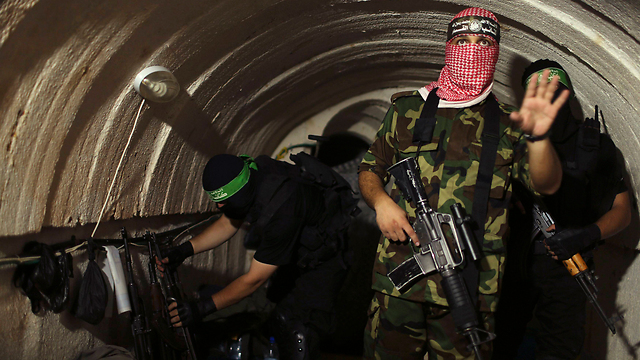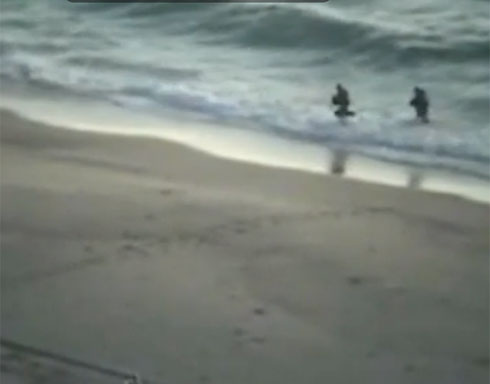
Beware of Hezbollah, prepare for Hamas
Op-ed: The real story of the current wave is the reawakening of Hamas' terrorist infrastructure in the West Bank to carry out attacks within the Green Line. The group feels that it has reached a sufficient level of preparedness to get through another war with Israel.
Institutionalized terrorism - namely shooting, bombs, car bombs and suicide attacks backed by terrorist organizations and supported by regimes such as Iran – is returning to the West Bank and from there to within the Green Line. This is the true face of the wave of terror that is now being organized behind the scenes which threatens to take the place of the spontaneous and popular wave of lone murderers, the knife-wielders and vehicular attackers.
Senior defense officials have been closely following the decision Hamas's military leadership in Gaza took in recent months to resume attacks in the West Bank and mainly inside the Green Line, even at the price of total confrontation with Israel.
According to the same sources, Hamas, a year and a half after Operation Protective Edge, feels that it has reached a sufficient level of preparedness to get through another war against the IDF. For Israel, this is a strategic warning: in the coming year it is likely to find itself in another war in the Gaza Strip.

Hezbollah, as of now, is a marginal factor in terms of institutionalized terror infrastructure in the West Bank. The discovery of the Hezbollah terrorist cell in Tulkarm is indicative of the terrorist organization's efforts to get back into the picture regarding the Palestinian conflict, just as it did during the second intifada when approximately 70 percent of Fatah cells operating against Israel did so under the auspices of Nasrallah. For him, the Palestinian front is the primary one from which he can operate against Israel without igniting the northern border. But the depth of his penetration on the ground is still far from his capabilities.
The real story here is Hamas. A few weeks ago the Shin Bet revealed Hamas's organization in the West Bank, which included explosives laboratories and the preparation of a suicide bomber to carry out an attack in Jerusalem. Hamas' military wing in Gaza, which commanded the cell, operated under the assumption that Israel cannot show restraint in the wake of a major attack in the heart of the capital. It believes that Israel would act aggressively in the West Bank – including damaging the Palestinian Authority - and simultaneously carry out widespread reprisals in Gaza.
The warning signs have been clear to Israel for several months now: Israel believes that Hamas is allowing itself to carry out large-scale attacks in the West Bank as it has completed basic preparation for delivering a surprise attack which it failed to do just before Operation Protective Edge. It is not impossible that it will penetrate into Israel, simultaneously and via a number of points – from the air, sea and tunnels - accompanied by a mortar fire and a massive blitz of rockets to cause the maximum amount of deaths.

Hamas has also developed a suitable ideology that would include an opening attack that would pummel and shock Israel and serve as a kind of Palestinian revenge for Israel's opening attack of Operation Pillar of Defense which killed dozens of police in Gaza.
It seems that at least part of the process of rebuilding the Gaza Strip has been completed: booby-trapped tunnels penetrating inside the Green Line have apparently been newly dug, including, if past experience is any indication, several openings for each tunnel. In addition, their special forces ("hanuchba") and divers continue their intensive training, their UAV strength was rebuilt and their rocket arsenal has been partially restocked.
.
The cell that planned an attack in Jerusalem was indeed captured - but is not the only one. The commander of the PA's security services, General Faraj, told American media that his men arrested about 300 Hamas members recently.
At the beginning of the current terror wave, four months ago, Hamas in the Gaza Strip and Hamas headquarters in Istanbul urged Palestinians to commit violent attacks and praised the stabbers and car rammers. Hamas, at the time, encouraged the wave of terror - but had not yet crossed the line by activating cells that it set up in the West Bank out of fear of Israeli retaliation.
Hamas's strategy was to try to destabilize Abbas's regime by creating unrest in the Palestinian street. On the other hand, Israel believed that Hamas was busy strengthening itself, was in financial distress due to the loss of support from Iran and had received a serious blow from the Egyptians who wiped out a large part of their smuggling tunnels. In addition, it still believed that Hamas still didn't have the ability nor the interest to risk a confrontation with the IDF.
Israel changed this estimation when it became clear that Hamas was instructing its people in the West Bank to once again carry out terrorist attacks inside the Green Line. And indeed, the cells were reawakened and several explosives laboratories were discovered. Simultaneously, money began to pour into those cells, messengers came from and went to the West Bank, and today it is clear that Hamas - led by Mohammed Deif – is changing direction and raising the stakes against Israel.










